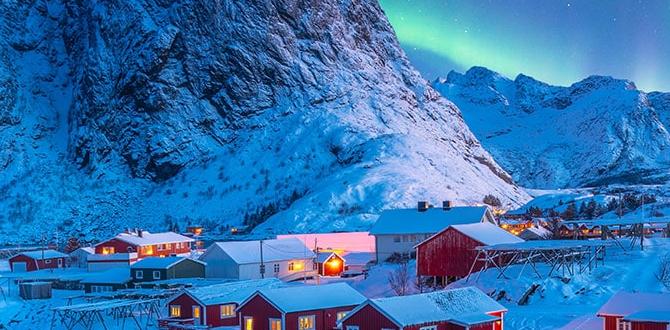Traveling solo as a woman in the Appalachians is completely doable with the right preparation. Focus on staying informed, planning your routes, packing smart, and listening to your intuition. This guide offers essential, beginner-friendly tips for a safe and amazing adventure.
Dreaming of exploring the majestic beauty of the Appalachian Mountains but feeling a little hesitant about going solo as a woman? You’re not alone! The idea of venturing into vast natural landscapes can be exciting, but safety and preparedness are always top of mind, especially when traveling alone.
Many wonder if it’s possible to hike trails, visit charming towns, and immerse themselves in the stunning scenery without a companion. The good news is, with a little planning and the right approach, solo female travel in the Appalachians can be incredibly rewarding and empowering. This guide is designed to give you the confidence and knowledge you need to start planning your unforgettable Appalachian journey. We’ll cover everything from choosing your destinations to staying connected and feeling secure every step of the way.
Discovering the Magic of the Appalachians Solo
The Appalachian Mountain range is a vast and varied playground, stretching over 1,500 miles through 13 states from Georgia to Maine. Within this immense natural wonder, you’ll find everything from gentle, rolling hills and historic small towns to rugged peaks and dense wilderness perfect for hiking, camping, and reflective exploration.
For the solo female traveler, the Appalachians offer a unique blend of solitude and community. You can find quiet trails for introspection or friendly local diners where you can strike up a conversation. It’s a destination that allows for both deep personal connection with nature and a welcoming embrace from local culture.
The appeal for solo female travel here lies in its accessibility and diverse offerings. Whether you’re an experienced hiker or a beginner looking for a scenic drive with charming detours, the Appalachians cater to all levels.
You can explore the iconic Blue Ridge Parkway, hike sections of the Appalachian Trail, visit historic mining towns, or discover local artisan crafts. The key to a successful solo trip is to approach it with a well-thought-out plan that prioritizes your comfort and safety, allowing you to fully embrace the adventure.
Your Essential Appalachian Solo Travel Checklist
Preparing for any trip, especially a solo adventure, starts with a solid checklist. For the Appalachians, this means considering the diverse environments you might encounter, from mountain trails to small towns. Here’s a breakdown of what you’ll need to think about:
1. Destination Deep Dive & Research
Before you pack a single item, dive deep into your intended destinations. The Appalachians are a sprawling region, so pinpointing specific areas or routes will make planning much easier and safer. Start by identifying what you want to experience: do you crave challenging hikes, picturesque drives, historical sites, or a mix? Research specific towns, national parks, and scenic byways. Look for information on:
- Trail difficulty and conditions.
- Accommodation options (hotels, B&Bs, campgrounds).
- Local amenities (grocery stores, gas stations, cell service availability).
- Points of interest and their accessibility.
- Local safety advisories or community forums.
Resources like the National Park Service for specific Appalachian parks, state tourism websites, and reputable travel blogs can be invaluable. Understanding the local terrain and typical conditions will help you pack appropriately and set realistic expectations for your activities.
2. Safety First: Planning & Awareness
Solo travel requires an extra layer of safety awareness. This isn’t about being fearful, but about being prepared and confident.
- Inform Someone: Always share your itinerary with a trusted friend or family member. Include your planned routes, accommodation details, and expected return times. Check in regularly.
- Research Local Conditions: Understand the weather patterns for the season you’re visiting. Mountain weather can change rapidly. Check for any alerts or closures on park websites.
- Know Your Limits: Be honest about your physical capabilities. Don’t push yourself too hard on trails, especially if you’re alone.
- Trust Your Gut: If a situation or person feels uncomfortable, remove yourself from it. Your intuition is your most powerful safety tool.
- Cell Service: Be aware that cell service can be spotty or non-existent in many mountainous areas. Download offline maps and consider carrying a satellite communication device for remote areas. Learn more about FCC guidelines on wireless devices during emergencies which can offer general preparedness tips.
- Local Resources: Know the location of the nearest ranger station, hospital, or law enforcement office.
3. Packing Smart: Comfort and Essentials
Your packing strategy will depend heavily on your planned activities – whether you’re car camping, staying in hotels, or hitting the trails. However, some essentials are universal for solo female travelers in the Appalachians.
Clothing & Footwear
- Layer Up: Pack breathable, moisture-wicking base layers, insulating mid-layers (like fleece or down), and a waterproof/windproof outer shell. This allows you to adapt to changing temperatures.
- Sturdy Footwear: Depending on your activities, bring well-broken-in hiking boots or comfortable walking shoes. Ensure they have good ankle support and traction.
- Socks: Wool or synthetic hiking socks are crucial to prevent blisters.
- Rain Gear: A waterproof jacket and pants are non-negotiable in the mountains.
- Sun Protection: Hat, sunglasses, and sunscreen are necessary even on cloudy days.
- Comfortable Casual Wear: For exploring towns and relaxing evenings.
Gear & Navigation
- Backpack: A comfortable daypack for hikes. If backpacking, a larger, properly fitted pack is essential.
- Navigation Tools: A physical map and compass are a must, especially if venturing into areas with no cell service. Learn how to use them! GPS devices or smartphone apps with downloaded offline maps are also great backups.
- First-Aid Kit: A comprehensive kit tailored to outdoor adventures, including any personal medications. Know how to use the contents.
- Headlamp or Flashlight: With extra batteries. Essential for early mornings, late evenings, or unexpected delays.
- Water Bottle or Hydration Reservoir: Stay hydrated. Consider a water filter or purification tablets for longer hikes.
- Snacks: High-energy snacks like trail mix, energy bars, and jerky.
- Multi-tool or Knife: Always handy for various small tasks.
- Emergency Whistle and Fire Starter: For signaling and survival.
Personal Care & Comfort
For any traveler, comfort is key. For those who might need them, planning for personal care items is just as important as packing a raincoat.
- Toiletries: Travel-sized essentials.
- Hand Sanitizer and Wipes: Especially useful on trails or when out and about.
- Insect Repellent: Essential in warmer months.
- Personal Care Needs: This can range from simple comfort items to specialized needs. For instance, if you require adult diapers or child diapers for long road trips, flights, or extended periods without easy access to facilities, packing discreet and comfortable options is vital. Brands offer various absorbencies and styles for confidence and peace of mind, ensuring your focus remains on the adventure. Search for reliable brands offering discreet packaging and excellent absorbency to suit your travel plans.
4. Transportation Choices
How you get around the Appalachians will significantly impact your experience. Consider these options:
Driving Yourself
Pros: Offers the most flexibility and freedom to explore remote areas and set your own schedule. Great for accessing trailheads and small towns not served by public transport.
Cons: Can be costly with gas, potential for car maintenance issues, and requires comfort with driving potentially winding or mountainous roads. Ensure your vehicle is in good condition before you leave.
Public Transportation & Ride-Sharing
Pros: Can be more affordable and environmentally friendly. Good for getting between larger towns or cities.
Cons: Limited in rural and mountainous areas, often infrequent, and may not reach specific attractions or trailheads.
Organized Tours/Shuttles
Pros: Good for specific experiences like guided hikes or scenic drives (e.g., Blue Ridge Parkway tours). Can offer built-in safety and expertise.
Cons: Less flexibility; you’re on a set schedule and may not be able to deviate.
Recommendation: For ultimate flexibility in the Appalachians, having your own vehicle (or a rental) is often the preferred method for solo female travelers. If you plan to drive, ensure you are comfortable with mountainous terrain and have a reliable vehicle. Always have roadside assistance information handy. For those sticking to main routes between towns, researching bus lines or local shuttle services is a good idea.
5. Accommodation: Your Safe Haven
Choosing the right accommodation is crucial for solo female travelers. Think about what makes you feel most secure and comfortable.
| Accommodation Type | Pros for Solo Female Travelers | Cons for Solo Female Travelers |
|---|---|---|
| Hotels/Motels | Often have staff available 24/7, security measures (locks, lighting), and predictable amenities. Easy to book online. | Can be more expensive. May be limited in very rural areas. Some budget options might lack adequate security. |
| Bed & Breakfasts (B&Bs) | Cozy atmosphere, often with a friendly innkeeper who can offer local tips. Smaller scale can feel more personal and secure. | Fewer amenities than hotels. May have less staff presence overnight if you need immediate assistance. |
| Campgrounds/Cabins | Great for nature immersion. Cabins offer more privacy and comfort than tents. Campgrounds often have rangers and other campers nearby. | Requires more self-reliance. Facilities can be basic. Less security than a locked hotel room. Tents offer minimal protection. |
| Vacation Rentals (e.g., Airbnb) | Can offer more space and a “home-like” feel. Often in residential areas. | Varies greatly in security and amenities. It’s crucial to read reviews carefully and ensure good local support or a responsive host. |
Tip: When booking, look for places with good reviews mentioning safety, good lighting, and friendly staff. For hotels, opt for rooms on higher floors (if you feel safer away from ground level) and ensure your door has a deadbolt and security chain. When arriving at any accommodation, take a moment to familiarize yourself with the exits and common areas.
Staying Connected and Safe on the Go
Connectivity and safety go hand-in-hand, especially when traveling solo. Being prepared means understanding your communication options and having a plan for emergencies.
Communication Strategies
- Cell Service: As mentioned, cell service can be extremely limited. Check coverage maps for your carrier for the specific areas you’ll be visiting before you go.
- Offline Maps: Download maps of your route and destinations using apps like Google Maps or Maps.me. This is a lifesaver when you lose signal.
- Satellite Communicators: For serious backcountry trips or remote exploration, consider renting or purchasing a satellite messenger (e.g., SPOT, Garmin inReach). These devices allow you to send SOS signals and text messages even without cell service. Many outdoor enthusiasts rely on these for peace of mind.
- Inform Your Contacts: Don’t just share your itinerary; establish check-in times. A simple text saying “Arrived safely at X” or “Heading to Y now” can reassure your contacts and confirm you’re okay.
Emergency Preparedness
- Emergency Contacts: Save emergency numbers (local police, park rangers) in your phone and write them down in your notebook.
- “911” Isn’t Universal: While 911 is the standard emergency number in the US and Canada, remember that service might not be available everywhere. If you can, use the specific number for park rangers or local authorities if you have it.
- Share Your Location: Many smartphones have features to share your live location with trusted contacts for a set period.
- Be Aware of Your Surroundings: When hiking, stay on marked trails. When in towns, be mindful of who is around you, especially after dark.
- Self-Defense: Consider carrying a personal safety alarm or pepper spray, ensuring you are familiar with local laws regarding their use.
Embracing the Appalachian Culture
The charm of the Appalachians extends beyond its landscapes to its rich culture and welcoming communities. Solo travel allows you to truly immerse yourself.
Small Towns and Local Flavors
Many Appalachian towns are brimming with history, artisan crafts, and local eateries. Step into a local diner for a hearty breakfast, visit a craft fair to find unique souvenirs, or explore a historic main street. Engaging with locals is often a highlight. Don’t be afraid to ask for recommendations – most residents are proud of their region and happy to share insights.
Hiking and Outdoor Etiquette
When hiking, especially on popular trails like those on the Appalachian Trail, be courteous to other hikers. Yield to those going uphill, keep noise levels down to appreciate nature’s sounds, and always practice Leave No Trace principles. This ensures the beautiful environment remains pristine for future visitors. Check out Leave No Trace’s 7 Principles for a comprehensive guide.
Responsible Tourism
Support local businesses by choosing locally owned accommodations, restaurants, and shops. This not only enriches your experience but also contributes to the economic well-being of the communities you visit. Be respectful of the local culture and traditions.
Solo Adventures: Popular Appalachian Destinations for Women
While the entire Appalachian range is beautiful, some areas are particularly well-suited for solo female travelers due to their accessibility, infrastructure, and range of activities.
1. The Blue Ridge Parkway, Virginia & North Carolina
This scenic byway is known as “America’s Favorite Drive.” It offers stunning vistas, numerous overlooks, hiking trails (from easy strolls to more challenging ones), and charming towns bordering the parkway. It’s ideal for a road trip, with plenty of places to stop and explore. You’ll find ample lodging options in towns like Roanoke, VA, Asheville, NC, and Boone, NC.
2. Great Smoky Mountains National Park, North Carolina & Tennessee
The most visited national park in the U.S. offers a vast wilderness experience. While popular, its size means you can find solitude. Numerous well-maintained trails cater to all levels, from the paved Gatlinburg Trail to the more strenuous ascents of Mount LeConte. Stay in gateway towns like Gatlinburg, TN, or Cherokee, NC.
3. Shenandoah National Park, Virginia
Easily accessible from Washington D.C., Shenandoah offers beautiful woodlands, waterfalls, and expansive views from Skyline Drive, which runs the length of the park. It’s known for its network of trails, including parts of the Appalachian Trail. Lodging options range from park lodges to nearby towns like Luray, VA.
4. West Virginia: New River Gorge & Canaan Valley
West Virginia offers rugged beauty and adventure. The New River Gorge National Park and Preserve is famous for its dramatic bridge and whitewater rafting, but also boasts excellent hiking. Canaan Valley Resort State Park offers scenic beauty, hiking, and winter sports. Towns like Fayetteville, WV, are great bases.
5. The Catskills & Adirondacks, New York
Though often considered separate ranges, these New York mountains are geologically part of the larger Appalachian system. They offer pristine lakes, extensive trail networks, and charming mountain towns like Woodstock and Lake Placid. They are well-supported by infrastructure for outdoor recreation.
FAQs: Your Appalachian Solo Travel Questions Answered
Q1: Is it safe for a woman to travel alone in the Appalachian Mountains?
Absolutely. Like any destination, safety depends on preparation and awareness. The Appalachian region is generally safe, with friendly communities. By informing others of your plans, staying aware of your surroundings, and trusting your instincts, solo female travel here can be incredibly secure and rewarding.
Q2: What’s the best time of year to visit the Appalachians solo?
Each season offers unique beauty. Spring (April-May) brings wildflowers and milder temperatures. Summer (June-August) is ideal for hiking but can be hot and humid, with thunderstorms. Autumn (September-October) is spectacular with fall foliage and cool, crisp air, making it a very popular time. Winter (November-March) offers solitude and chances for snow, but many facilities and trails may be closed, and weather can be harsh.




